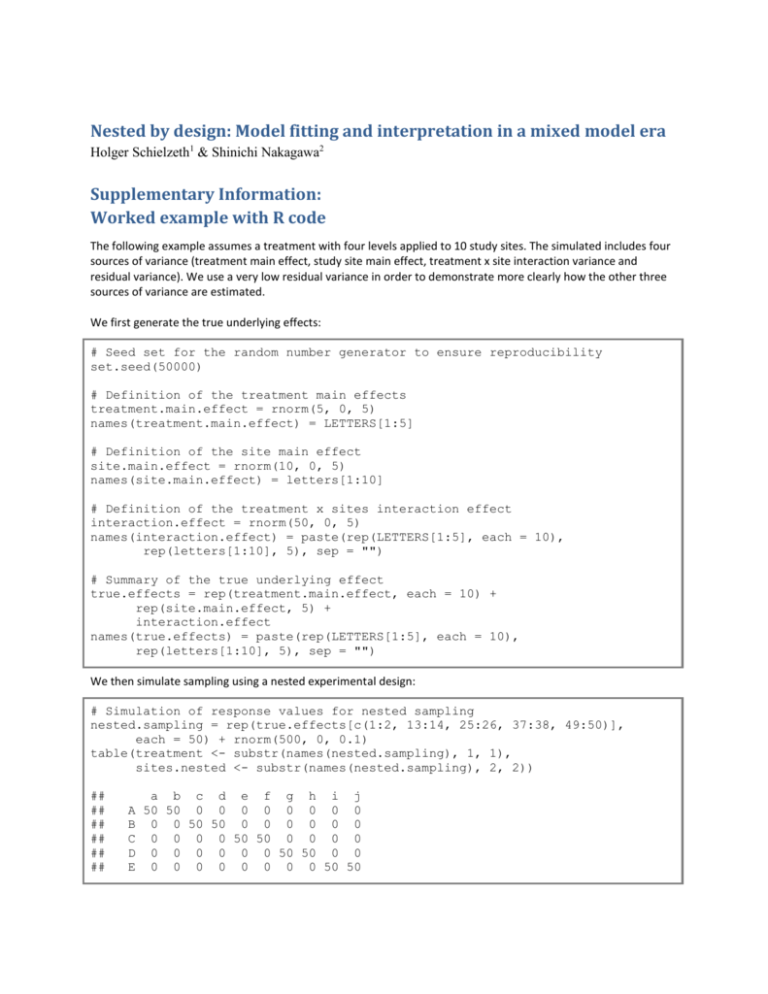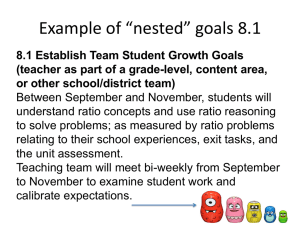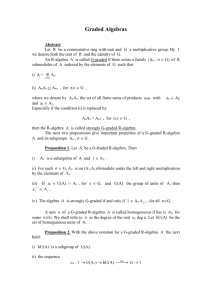Schielzeth and Nakagawa Appendix
advertisement

Nested by design: Model fitting and interpretation in a mixed model era
Holger Schielzeth1 & Shinichi Nakagawa2
Supplementary Information:
Worked example with R code
The following example assumes a treatment with four levels applied to 10 study sites. The simulated includes four
sources of variance (treatment main effect, study site main effect, treatment x site interaction variance and
residual variance). We use a very low residual variance in order to demonstrate more clearly how the other three
sources of variance are estimated.
We first generate the true underlying effects:
# Seed set for the random number generator to ensure reproducibility
set.seed(50000)
# Definition of the treatment main effects
treatment.main.effect = rnorm(5, 0, 5)
names(treatment.main.effect) = LETTERS[1:5]
# Definition of the site main effect
site.main.effect = rnorm(10, 0, 5)
names(site.main.effect) = letters[1:10]
# Definition of the treatment x sites interaction effect
interaction.effect = rnorm(50, 0, 5)
names(interaction.effect) = paste(rep(LETTERS[1:5], each = 10),
rep(letters[1:10], 5), sep = "")
# Summary of the true underlying effect
true.effects = rep(treatment.main.effect, each = 10) +
rep(site.main.effect, 5) +
interaction.effect
names(true.effects) = paste(rep(LETTERS[1:5], each = 10),
rep(letters[1:10], 5), sep = "")
We then simulate sampling using a nested experimental design:
# Simulation of response values for nested sampling
nested.sampling = rep(true.effects[c(1:2, 13:14, 25:26, 37:38, 49:50)],
each = 50) + rnorm(500, 0, 0.1)
table(treatment <- substr(names(nested.sampling), 1, 1),
sites.nested <- substr(names(nested.sampling), 2, 2))
##
##
##
##
##
##
a b c d e f g h i j
A 50 50 0 0 0 0 0 0 0 0
B 0 0 50 50 0 0 0 0 0 0
C 0 0 0 0 50 50 0 0 0 0
D 0 0 0 0 0 0 50 50 0 0
E 0 0 0 0 0 0 0 0 50 50
# Simulation of response values for crossed sampling
crossed.sampling = rep(true.effects[c(1:50)], each = 10) +
rnorm(500, 0, 0.1)
table(treatment <- substr(names(crossed.sampling), 1, 1),
sites.crossed <- substr(names(crossed.sampling), 2, 2))
##
##
##
##
##
##
A
B
C
D
E
a
10
10
10
10
10
b
10
10
10
10
10
c
10
10
10
10
10
d
10
10
10
10
10
e
10
10
10
10
10
f
10
10
10
10
10
g
10
10
10
10
10
h
10
10
10
10
10
i
10
10
10
10
10
j
10
10
10
10
10
Next we fit the models with treatment as a fixed effect and site as a random effect:
# package lme4 might need to be downloaded: install.packages('lme4')
require(lme4)
# Fit of the model for the nested dataset
nested.mod = lmer(nested.sampling ~ factor(treatment) +
(1 | sites.nested))
summary(nested.mod)
##
##
##
##
##
##
##
##
##
##
##
##
##
##
##
##
##
##
##
##
##
##
##
##
Linear mixed model fit by REML
Formula: nested.sampling ~ factor(treatment) + (1 | sites.nested)
AIC BIC logLik deviance REMLdev
-789 -759
401
-775
-803
Random effects:
Groups
Name
Variance Std.Dev.
sites.nested (Intercept) 86.97093 9.3258
Residual
0.00968 0.0984
Number of obs: 500, groups: sites.nested, 10
Fixed effects:
(Intercept)
factor(treatment)B
factor(treatment)C
factor(treatment)D
factor(treatment)E
Estimate Std. Error t value
-9.80
6.59
-1.49
7.35
9.32
0.79
5.41
9.32
0.58
13.77
9.32
1.48
20.77
9.32
2.23
Correlation of Fixed Effects:
(Intr) fct()B fct()C fct()D
fctr(trtm)B -0.707
fctr(trtm)C -0.707 0.500
fctr(trtm)D -0.707 0.500 0.500
fctr(trtm)E -0.707 0.500 0.500 0.500
# Fit of the model for the crossed dataset
crossed.mod = lmer(crossed.sampling ~ factor(treatment) +
(1 | sites.crossed))
summary(crossed.mod)
##
##
##
##
##
##
##
##
##
##
##
##
##
##
##
##
##
##
##
##
##
##
##
##
Linear mixed model fit by REML
Formula: crossed.sampling ~ factor(treatment) + (1 | sites.crossed)
AIC BIC logLik deviance REMLdev
2769 2798 -1377
2759
2755
Random effects:
Groups
Name
Variance Std.Dev.
sites.crossed (Intercept) 45.0
6.71
Residual
13.3
3.65
Number of obs: 500, groups: sites.crossed, 10
Fixed effects:
(Intercept)
factor(treatment)B
factor(treatment)C
factor(treatment)D
factor(treatment)E
Estimate Std. Error t value
-10.664
2.152
-5.0
7.988
0.516
15.5
8.548
0.516
16.6
13.649
0.516
26.5
18.096
0.516
35.1
Correlation of Fixed Effects:
(Intr) fct()B fct()C fct()D
fctr(trtm)B -0.120
fctr(trtm)C -0.120 0.500
fctr(trtm)D -0.120 0.500 0.500
fctr(trtm)E -0.120 0.500 0.500 0.500
We see that the interaction variance inflates the site variance estimate in the nested design, whereas it is assigned
to the residual variance in the crossed model. Note that both models do not explicitly model the interaction
variance.
We can also fit the model with two random effects. The model can be fitted to the nested and the crossed dataset
using the exact same syntax, since the coding employed here reflects implicit nesting. Note the shift in the
assignment of the interaction variance to the site variance in the nested dataset and to the residual component in
the crossed model.
# Fit of a random effect model for the nested dataset (using the syntax of
# crossed model fitting)
nested.raneff.mod <- lmer(nested.sampling ~ (1 | treatment)
+ (1 | sites.nested))
summary(nested.raneff.mod)
##
##
##
##
##
##
##
##
##
##
##
##
##
Linear mixed model fit by REML
Formula: nested.sampling ~ (1 | treatment) + (1 | sites.nested)
AIC
BIC logLik deviance REMLdev
-765.2 -748.3 386.6
-768.8 -773.2
Random effects:
Groups
Name
Variance
Std.Dev.
sites.nested (Intercept) 87.97
9.33
treatment
(Intercept) 20.74
4.55
Residual
0.01
0.10
Number of obs: 500, groups: sites.nested, 10; treatment, 5
Fixed effects:
Estimate Std. Error t value
(Intercept) -0.335
3.583
-0.093
# Fit of a random effect model for the crossed dataset
crossed.raneff.mod <- lmer(crossed.sampling ~ (1 | treatment)
+ (1 | sites.crossed))
summary(crossed.raneff.mod)
##
##
##
##
##
##
##
##
##
##
##
##
##
##
Linear mixed model fit by REML
Formula: crossed.sampling ~ (1 | treatment) + (1 | sites.crossed)
AIC BIC logLik deviance REMLdev
2791 2808 -1392
2788
2783
Random effects:
Groups
Name
Variance Std.Dev.
sites.crossed (Intercept) 44.98
6.71
treatment
(Intercept) 45.97
6.78
Residual
13.30
3.65
Number of obs: 500, groups: sites.crossed, 10; treatment, 5
Fixed effects:
Estimate Std. Error t value
(Intercept)
-1.008
3.703 -0.272
We want to demonstrate that the model fit for the nested dataset using the syntax of crossed random effects gives
the correct answer for a nested data structure. It is currently not even possible to use a special syntax for nested
effects in lmer(). But we can use the lme() for a comparison (compare nested.raneff.mod to
nested.raneff.mod.lme). The estimates are essentially the same (up to slight differences due to different
implementations). Note that random effect variances are presented as random effect standard deviations in
summary(lme()).
# This might require downloading package nlme: install.packages('nlme'))
require(nlme)
nested.raneff.mod.lme <- lme(nested.sampling ~ 1, random = ~ 1 | treatment/
sites.nested)
summary(nested.raneff.mod.lme)
##
##
##
##
##
##
##
##
##
##
##
##
##
##
##
Linear mixed-effects model fit by REML
AIC
BIC
logLik
-765.2
-748.3
386.5836
Random effects:
Formula: ~1 | treatment
(Intercept)
StdDev:
4.55
Formula: ~1 | sites.nested %in% treatment
(Intercept)
Residual
StdDev:
9.33
0.098
Fixed effects: nested.sampling ~ 1
Value
Std.Error DF
t-value
(Intercept) -0.335
3.584
490
-0.09
Number of Observations: 500
Number of Groups:
p-value
0.93
##
##
treatment sites.nested %in% treatment
5
10
So far, we have not explicitly modeled the interaction variance component. But if the experimental design is
crossed and there is replication within cells, we can easily extend the random effect model to estimate the
interaction variance. Note that this reduces primarily the residual variance component (that was simulated very
low).
# Fit of a random effect model for the crossed dataset including the
interaction variance
interaction.raneff.mod <- lmer(crossed.sampling ~ (1 | treatment)
+ (1 | sites.crossed) + (1 | names(crossed.sampling)))
summary(interaction.raneff.mod)
##
##
##
##
##
##
##
##
##
##
##
##
##
##
##
##
##
Linear mixed model fit by REML
Formula: crossed.sampling ~ (1 | treatment) + (1 | sites.crossed)
+ (1 | names(crossed.sampling))
AIC
BIC logLik deviance REMLdev
-362.2 -341.1 186.1
-367.7 -372.2
Random effects:
Groups
Name
Variance Std.Dev.
names(crossed.sampling) (Intercept) 17.94
4.24
sites.crossed
(Intercept) 41.66
6.45
treatment
(Intercept) 44.31
6.66
Residual
0.01
0.10
Number of obs: 500, groups: names(crossed.sampling), 50;
sites.crossed, 10; treatment, 5
Fixed effects:
Estimate Std. Error t value
(Intercept)
-1.008
3.659 -0.276









